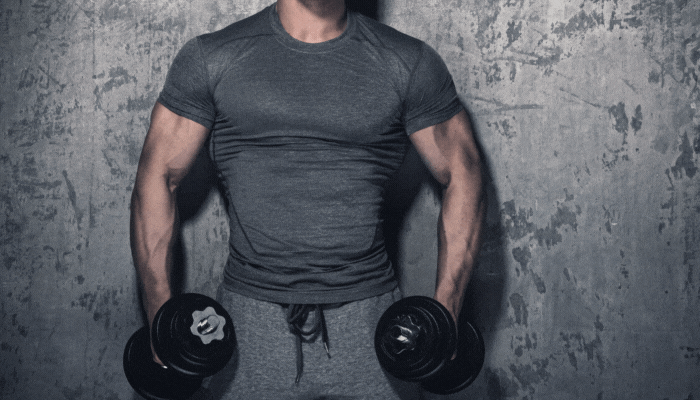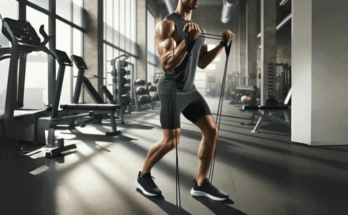Arm Blaster Hammer Curl
The arm blaster is a training tool that helps you isolate your biceps by preventing you from swinging the weight. This allows you to focus on the concentric and eccentric phases of the bicep curl, which leads to more muscle growth.

How to do It?
- Place the arm blaster on the bench.
- Sit down on the bench with your feet flat on the floor.
- Grip the dumbbell or barbell with an underhand grip (palms facing inwards).
- Rest your upper arms on the arm blaster.
- Slowly curl the weight up towards your shoulders, keeping your upper arms still.
- Squeeze your biceps at the top of the movement.
- Slowly lower the weight back down to the starting position.
- Keep your core engaged throughout the movement.
- Don’t use momentum to swing the weight up.
- Focus on using a slow and controlled tempo.
Benefits:
- Increased bicep growth: The arm blaster hammer curl effectively isolates the biceps, leading to more muscle growth.
- Improved bicep strength: This exercise strengthens the bicep muscles, which can improve your performance in other exercises.
- Reduced risk of injury: The arm blaster helps to stabilize the elbows, which can help to reduce the risk of injury.
- Increased bicep definition: This exercise can help to improve the definition of your biceps.
Muscles Worked:
- Primary: Biceps brachii (long head)
- Secondary: Brachialis, brachioradialis
Dumbbell Curl on Arm Blaster
The arm blaster is a specialized training device worn around the neck during bicep exercises. Its design restricts your upper arm movement, preventing momentum and forcing you to focus solely on contracting your bicep muscles. This isolation allows for a more intense and controlled workout, maximizing muscle engagement and potential gains.

How to do It?
- Secure the arm blaster comfortably around your neck.
- Stand with your feet shoulder-width apart and knees slightly bent.
- Hold a dumbbell in each hand with an overhand grip (palms facing out).
- Rest your upper arms on the arm blaster pad, ensuring they remain stationary throughout the exercise.
- Slowly curl the dumbbells up towards your shoulders, keeping your elbows tucked in and close to your body.
- Focus on squeezing your biceps at the peak of the contraction.
- Breathe out as you curl the weights up.
- Slowly lower the dumbbells back down to the starting position with control, ensuring your elbows stay tucked in.
- Breathe in as you lower the weights.
- Choose a weight that allows you to maintain proper form throughout the entire set.
- Concentrate on using a slow and controlled tempo for both the lifting and lowering phases.
- Avoid swinging the weights or using momentum to complete the exercise.
- Maintain a neutral spine and core engagement throughout the movement.
Benefits:
- Greater Bicep Isolation: The arm blaster effectively restricts upper arm movement, forcing your biceps to do the majority of the work. This leads to more targeted muscle growth and definition.
- Improved Mind-Muscle Connection: By limiting secondary muscle involvement, the arm blaster helps you focus solely on contracting your biceps, enhancing the mind-muscle connection and promoting better control over the movement.
- Increased Bicep Strength: The isolation and controlled nature of the exercise allow you to progressively overload your biceps, leading to increased strength over time.
- Reduced Risk of Injury: The arm blaster provides support for your elbows, potentially reducing the risk of injury during bicep curls.
Muscles Worked:
- Primary: Biceps brachii (both long and short heads)
- Secondary: Brachialis, brachioradialis
Standing One Arm Chest Stretch
This stretch targets the major chest muscles (pectoralis major and minor), as well as the anterior deltoids and rotator cuff muscles in the shoulder. It helps to lengthen and loosen these muscles, which can improve your posture, prevent pain, and enhance your performance in activities that require arm movement, such as swimming, throwing, or lifting weights.

How to do It?
- Find a Wall or Doorway: Locate a sturdy wall or doorway to use for support.
- Position Yourself: Stand facing the wall with your feet hip-width apart and about a foot away from the wall.
- Extend Your Arm: Reach your left arm out to the side and place your palm flat against the wall at shoulder height. Your elbow should be bent at a 90-degree angle.
- Rotate Your Torso: Gently rotate your torso to the right, away from the wall. Keep your hips facing forward and your core engaged.
- Deepen the Stretch: As you rotate, allow your chest to open and feel the stretch in your pectoral muscles and front of your shoulder. You can adjust the distance of your feet from the wall and the angle of your body to find the most comfortable and effective stretch.
- Hold and Release: Hold the stretch for 30 seconds to 1 minute, breathing deeply and slowly. Repeat the stretch on the other side.
Benefits:
- Improved chest and shoulder flexibility: This stretch helps to lengthen and loosen tight muscles in your chest and shoulders, which can improve your posture, prevent pain, and increase your range of motion.
- Enhanced breathing: By opening up your chest, this stretch can improve your lung capacity and breathing.
- Reduced risk of injury: Improved flexibility can help to reduce the risk of injury in your shoulders and chest.
- Improved athletic performance: Increased range of motion in your upper body can benefit various athletic activities.
Muscles Worked:
- Primary: Pectoralis major, pectoralis minor, anterior deltoids
- Secondary: Rotator cuff muscles (supraspinatus, infraspinatus, teres minor, subscapularis)
Lever Bicep Curls
This exercise utilizes a specialized piece of equipment called a lever arm curl machine. The machine features a weight stack and padded handles that allow you to isolate your biceps with minimal assistance from other muscle groups.

How to do It?
- Adjust the Machine: Set the weight stack to a challenging but manageable weight. Ensure the padded handles are at a comfortable height for your elbow placement.
- Position Yourself: Sit on the seat and grasp the handles with an underhand grip (palms facing upward). Rest your upper arms firmly against the padded support.
- Curl the Handles: Slowly curl the handles towards your shoulders, keeping your upper arms stationary and elbows tucked in close to your body. Focus on squeezing your biceps at the peak of the contraction.
- Lower the Handles: Slowly lower the handles back to the starting position with control, maintaining constant tension in your biceps.
- Repetitions and Sets: Complete 8-12 repetitions for 3-4 sets.
Benefits:
- Increased Bicep Growth: The constant tension provided by the lever machine maximises muscle fibers engagement, leading to significant bicep growth.
- Improved Bicep Strength: The controlled nature of the exercise builds strength in your biceps, enhancing your performance in other exercises.
- Reduced Risk of Injury: The machine’s design provides stability and support, reducing the risk of injury compared to free weight bicep curls.
- Enhanced Mind-Muscle Connection: The isolation of the biceps allows for a deeper mind-muscle connection, improving your control over the exercise and maximizing the effectiveness of your workout.
Muscles Worked:
- Primary: Biceps brachii (long and short heads)
- Secondary: Brachialis, brachioradiali
Cable Incline Bicep Curl
This exercise utilizes a cable machine with an incline bench and a V-bar attachment. By performing the curl on an incline bench, you can isolate the long head of the bicep more effectively.

How to do It?
- Set Up: Attach a V-bar attachment to the cable machine and set the weight to a challenging but manageable level. Position the incline bench at a 45-degree angle and adjust the seat height so your elbows are comfortably bent at 90 degrees when you grab the V-bar.
- Grab the V-bar: Sit down on the bench and grasp the V-bar with an underhand grip, palms facing upwards. Keep your elbows tucked in close to your body and your upper arms stationary on the bench pad.
- Curl the Bar: Slowly curl the V-bar towards your shoulders, keeping your torso stable and upper arms stationary. Focus on squeezing your biceps at the peak of the contraction.
- Lower the Bar: Slowly lower the V-bar back to the starting position with control, maintaining constant tension in your biceps.
- Repetitions and Sets: Aim for 8-12 repetitions per set, performing 3-4 sets in total.
Benefits:
- Increased Bicep Growth: The cable machine provides constant tension throughout the entire range of motion, maximizing muscle fiber engagement and promoting significant bicep growth.
- Improved Bicep Strength: The controlled nature of the exercise helps build strength in your biceps, leading to improved performance in other exercises.
- Targeted Long Head Bicep Development: The incline bench position isolates the long head of the bicep, which is often neglected in traditional bicep curls.
- Reduced Risk of Injury: The cable machine provides a stable platform and reduces stress on your joints compared to free weight bicep curls.
- Enhanced Mind-Muscle Connection: The isolation of the biceps allows for a deeper mind-muscle connection, helping you control the exercise more effectively.
Muscles Worked:
- Primary: Biceps brachii (long head)
- Secondary: Biceps brachii (short head), brachialis, brachioradialis



